This website uses cookies so that we can provide you with the best user experience possible. Cookie information is stored in your browser and performs functions such as recognising you when you return to our website and helping our team to understand which sections of the website you find most interesting and useful.
Raw materials: the building blocks of sustainable spirits
By Nicola CarruthersWhile the wine trade has been pioneering the use of biodynamic farming methods, the spirits sector has been hiding its light under a bushel – but some brands are turning their attention to sustainable base materials.
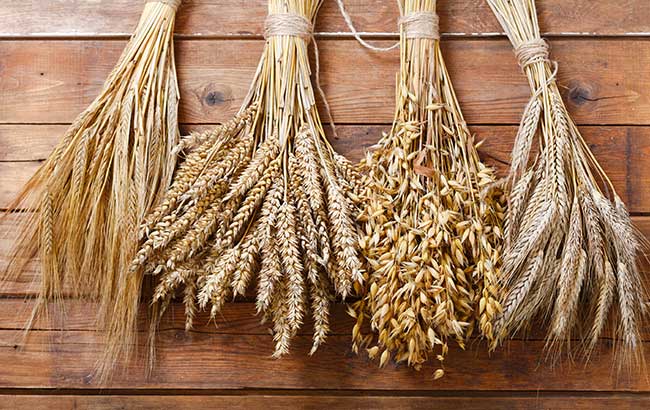
*This feature was originally published in the December 2021 issue of The Spirits Business magazine.
Sustainable environmental practices are critical to the continual production of the high‐quality products that consumers of spirits enjoy today.
The process of making a spirit is one that has environmental, social and economic implications. More than ever, brands are assessing their environmental footprints by considering their production methods, distillation techniques, raw ingredients, packaging, shipping, energy consumption and labour standards.
Consumers have also become increasingly interested in how a spirit is produced, and are seeking out brands that are committed to local ingredients and sustainable farming. Progressively, producers have begun distilling their spirits with discarded ingredients, such as grapes, peas and banana peel.
According to Tim Etherington‐Judge, co-founder of sustainable Calvados brand Avallen, producers are lagging when it comes to using sustainable base materials and being transparent. “What’s interesting is that spirits brands don’t talk about raw materials as much,” he says. “Tequila and agave spirits are much more connected with raw materials than rum, whisky or vodka. When does a gin distiller ever talk about what the neutral grain spirit (NGS) is made of?”
One brand seeking to showcase its sustainable credentials through its base materials is Scottish single‐estate distiller Arbikie, which unveiled the world’s first climate positive gin made from peas in February 2020, following a five‐year project. The gin, called Nàdar, has a carbon footprint of ‐1.54kg of CO2e (carbon dioxide equivalent) per 700ml bottle. By using peas to make the gin instead of more common base ingredients such as wheat, barley or maize, Arbikie was able to eliminate the use of synthetic nitrogen fertiliser, avoiding any negative impact on waterways, air and soil.
The brand also said that peas benefit the ecosystem by improving soil quality and offsetting synthetic nitrogen fertiliser requirements of other crops that follow peas in the crop rotation. The release of the gin was followed in August 2020 by Nàdar vodka. Arbikie also created Kirsty’s Gin using ‘wonky’ potatoes as the base spirit. “In terms of sourcing a base spirit, there’s an opportunity for everyone to do better,” says Iain Stirling, director of Arbikie. “The gin industry will buy in wheat and white spirit. We’ve been lucky to grow our own ingredients and that’s because we’re farmers, but there’s an opportunity for the whole drinks industry to do that.”
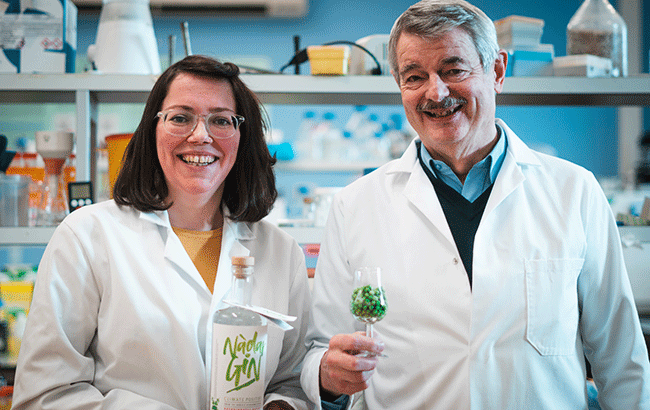
Arbikie planted rye in 2014 and four years later launched Scotland’s first Highland rye single grain whisky. A new Highland rye whisky is due to launch by the end of this year. The producer has also started growing heritage barley crops to use as base materials for its whiskies.
The next step in Arbikie’s sustainability journey is to look at powering the distillery with green hydrogen. The project, created in partnership with Locogen and Logan Energy, was recently given a funding boost of £3 million (US$4m) from the UK government.
Eco-friendly
One of the world’s most sustainable spirits is Calvados, says Etherington‐Judge, who sought to create the most eco‐friendly spirit possible. He founded Calvados brand Avallen with wine and spirits specialist Stephanie Jordan in 2019. He says: “We asked the question that I don’t know if any other spirits company has asked, which was, if you put aside price and flavour, what’s the best raw material from an environmental perspective to make alcohol from? If you look at the spirits we drink, so much of it is based on the price of the raw material; the reason that grain‐based whiskey and rum really dominate is that the raw material is extremely cheap.”
After some analysis, the duo discovered that apples came out on top as the most sustainable base material. “We were an accidental Calvados,” he adds. Produced in Normandy, France, Avallen Calvados is made from apples, and aged in French oak barrels for two years. The fruit comes from around 300 orchards within 20 kilometres, and the farmers get a fixed price for the apples, Etherington‐Judge explains. The apple waste is also reused as cattle stock, or is sent to a biodigester.
“Once we get the apples to the distillery, the only water that is used is to wash the apples,” he explains. “We wash them and it is recirculated 25 times. We wash the apples in brown water, but because it’s not been treated in any way, legally we can put it back in the bottle.”
Avallen has also partnered with Cool Farm Tool to provide a full analysis of the environmental impact of its orchards. Etherington‐Judge says: “We’ll get a better understanding of the carbon sequestering and the water management of the orchards. Once we have that picture, we can work on improving. Avallen is all about trying to blend the traditional techniques of making Calvados with cutting‐edge digital technology, blockchain and provenance.” Avallen has also begun its first harvest using apples that have been certified organic.
Foxhole Spirits went down the waste route for its portfolio of gins and a rum. The company unveiled its first expression in 2016, called Foxhole Gin, which was made from English wine grapes that are typically discarded. Foxhole Gin presses the unused juice from grapes grown for wine in Sussex vineyards. In 2019, the producer introduced Hyke Gin, which uses surplus table grapes, followed by botanical rum Mad City, made from Fairtrade‐certified distillates. Hyke Gin Very Special was launched in May this year, replacing the flagship Foxhole Gin. The base of Hyke Gin Very Special is the same as the original gin except for the addition of a drop of brandy.
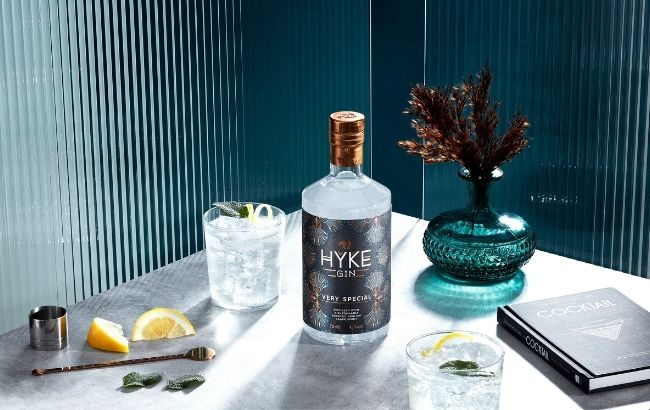
Surplus materials
James Oag‐Cooper, managing director of Foxhole Spirits, explains: “The goal is to use as much surplus material as we can. The best way to do that is to look at which spirits markets are exciting and have great commercial potential. How can we create a sustainable business, based on sustainable raw materials? Gin was the first thing to do.”
He says food waste is a global issue. “There’s so much potential in surplus materials, whether they get sourced from agriculture or the English wine industry.”
Rum producer Diplomático is also on a mission to reduce waste through its Distilled Consciously programme. The brand has partnered with different organisations dedicated to fighting food waste. “From a production point of view, we have an operation that is extremely efficient when it comes to minimising waste,” explains Edouard Beaslay, global director for the brand. “Over the past couple of years, we decided that we wanted to extend this to something that we could relate to in different markets, and tackle waste fast.” The company has partnered with restaurants in the US and Canada to minimise their food waste. The plan is to scale up this initiative to markets in Europe.
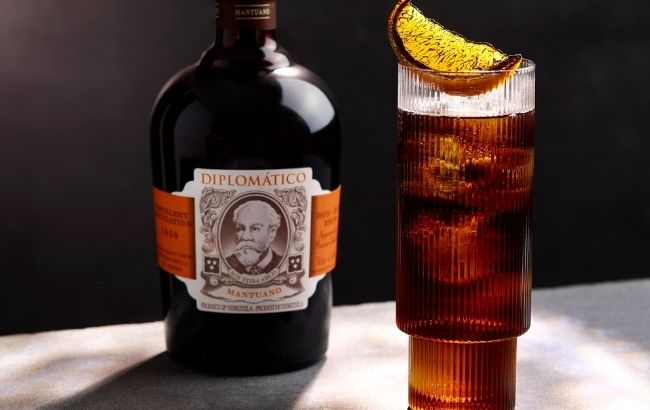
Meanwhile, many firms have made commitments to extracting peat responsibly and protecting the peatland. Peatlands play a key role in Scotch whisky production, as they contain the peat stores that are sometimes used to flavour the spirit, and are crucial to the industry’s water supply.
Drained or burning peatlands emit about two billion tonnes of carbon dioxide each year – around 5% of all emissions resulting from human activity, according to The Economics of Peatlands Conservation, Restoration and Sustainable Management policy report by the UN Environment Programme and the Global Peatlands Initiative.
The restoration of peatland could cut greenhouse gas emissions by 800 million metric tonnes per year, the report noted. It also found that undervaluation and underinvestment are the main causes of peatland mismanagement. It called for investments of up to US$46 billion annually by 2050 to halve the emissions currently produced by draining and burning peatlands.
One producer pledging to fight for peatlands is Beam Suntory, which recently unveiled a US$4m project to restore more than 1,300 hectares by 2030 – enough to produce the same amount of peat the firm harvests each year for its Scotch business.
Responsible harvesting
Alistair Longwell, senior manager, Scotch distillation and maturation operations at Beam Suntory UK, says: “We’ve always looked to harvest responsibly. All we’re doing now is going a step further, and we’re going to be regenerating and committing to regenerating enough peat to offset the volume that we harvest. It’s a huge target we’re going after. To do that we have to go beyond our own land ownership. We own land on Islay, and our focus over the first three or four years is there, so we’ll have to engage with third parties, and identify people we can collaborate with.” The project pilot has kicked off at Ardmore Distillery, in partnership with the James Hutton Institute and and Forestry and Land Scotland.
“People are starting to understand there’s a lot of carbon bound up in peatlands,” says Longwell, who notes that they store twice as much carbon as all of the world’s forests.
Ireland’s Waterford Distillery also turned its attention to biodynamic farming to add more flavour to its whiskey, a technique that owner Mark Reynier trialled at Bruichladdich Distillery in Scotland when he was managing director there.
This year saw Waterford release Biodynamic: Luna 1.1, the first whiskey made solely from biodynamic barley. The distillery worked with three barley farmers in Ireland who practise biodynamic agriculture, a set of farming methods first defined by Austrian philosopher Rudolf Steiner in 1924, and more often applied to wine production.
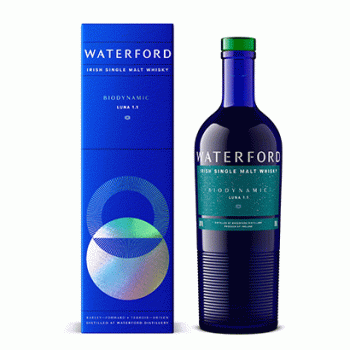
“The idea fundamentally of sourcing your primary raw ingredient from as close to the distillery as possible is a no‐brainer,” says Reynier. “It’s how it used to be in the 18th century. Little farm distilleries repurposed barley from eating it to drinking it. They would have had far more terroir‐derived characteristics than they do now because they’re all buying the same barley from the same source. That’s the source of your primary flavours.”
Waterford’s growers have taken on biodynamic practices including planting seeds in keeping with phases of the moon, using horses for ploughing and burying manure-filled cow horns during certain times of the year for fertilisation benefits. Reynier says his method is not cheap but “it’s a cost that I’m prepared to absorb because we are on a quest for natural flavours”.
Reynier notes there is a problem with the industry promoting that 80% of whisky flavour comes from the wood and “has nothing to do with barley”. He explains: “That’s a bit of a worry to me because barley produces more than 2,000 flavour compounds. A spirit made from corn doesn’t have the same complexity or the same flavour profile as a spirit produced from malted barley. If barley is the source of all that flavour, why are we not all looking at where that barley grows and rejoicing in the variety of flavours that we can get? There are logistical challenges, and I equally understand that the scale of the whisky industry means that they need to have a stability of supply. I just believe there’s a different way of doing it and going back to how it used to be.”
Meanwhile, Jack Daniel’s owner Brown‐Forman is working to bring rye back to the state of Kentucky in partnership with the American Farmland Trust. The aim of the 10‐year project is to have 10,000 acres of Kentucky rye growing by 2030. “Right now, our Woodford Reserve brand is testing the quality of the rye grown here,” says Suzette Carty, Brown‐Forman’s director of global sustainability. Using rye as a cover crop is a regenerative agriculture practice that helps sequester carbon to help mitigate climate change, Carty adds. “Having our crop grown closer to the source of production is a lot better for the climate,” she says.
Another company focusing on regenerative agriculture is The Lost Explorer Mezcal, which has pledged to grow three agave plants for each one used. Furthermore, any waste created is turned into fertiliser or used to make a copita – a drinking vessel for mezcal. CEO Tanya Clarke notes the importance of growing different varieties of agave. “If everyone grew espadin and they were all cloned and there was an insect issue it could really affect an industry.” She adds the industry must replant agaves and take a longterm view: “We’re planting now for agave that obviously won’t be used for 10 years.”
Expenditure is one of the biggest challenges for Foxhole Spirits when it comes to using raw materials. Oag-Cooper says: “It costs us more to make a bottle of gin than NGS. We go through a three‐step process, including sourcing raw material then adding botanicals again. The cost burden is on us. We must be competitive in terms of pricing. The thing that limits us more than anything is the capabilities of taking a raw material, going through the fermentation and distillation to meet the EU regulation for NGS. We would love to make a vodka, from something like potatoes, or grapes, but we don’t have the kit to strip everything to neutral. There’s so much untapped potential.
“Sustainability costs money, the more we do it and the more companies get involved in doing it, the move innovative we can become with the process, and the cheaper it becomes.”

